Between Research and Practice: Experts on Implementing Sustainable Construction
Abstract
:1. Introduction
2. The Built Environment as a Socio-Technical Network
3. Key Terms
3.1. Stakeholders
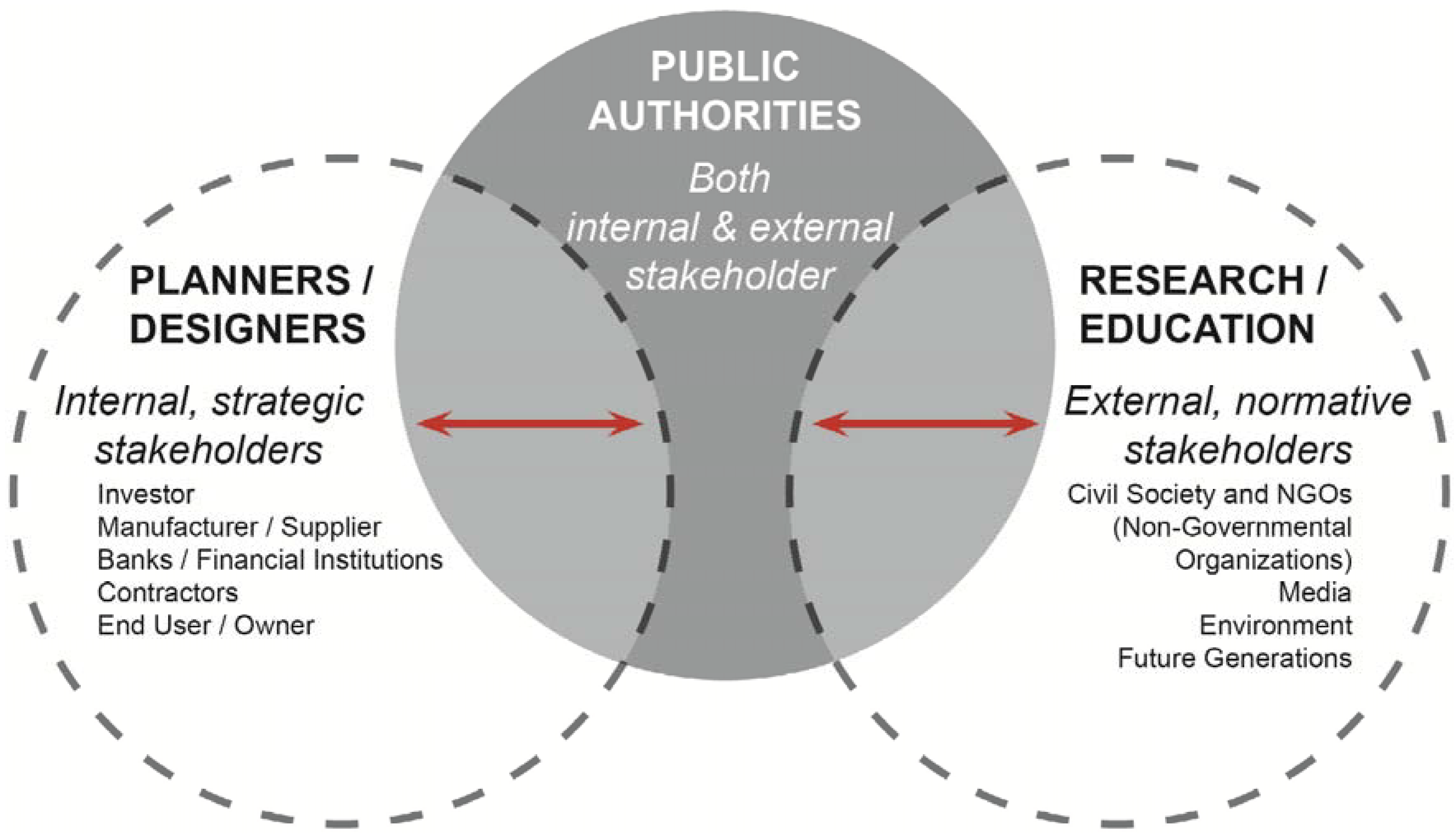
3.2. Experts & Expertise
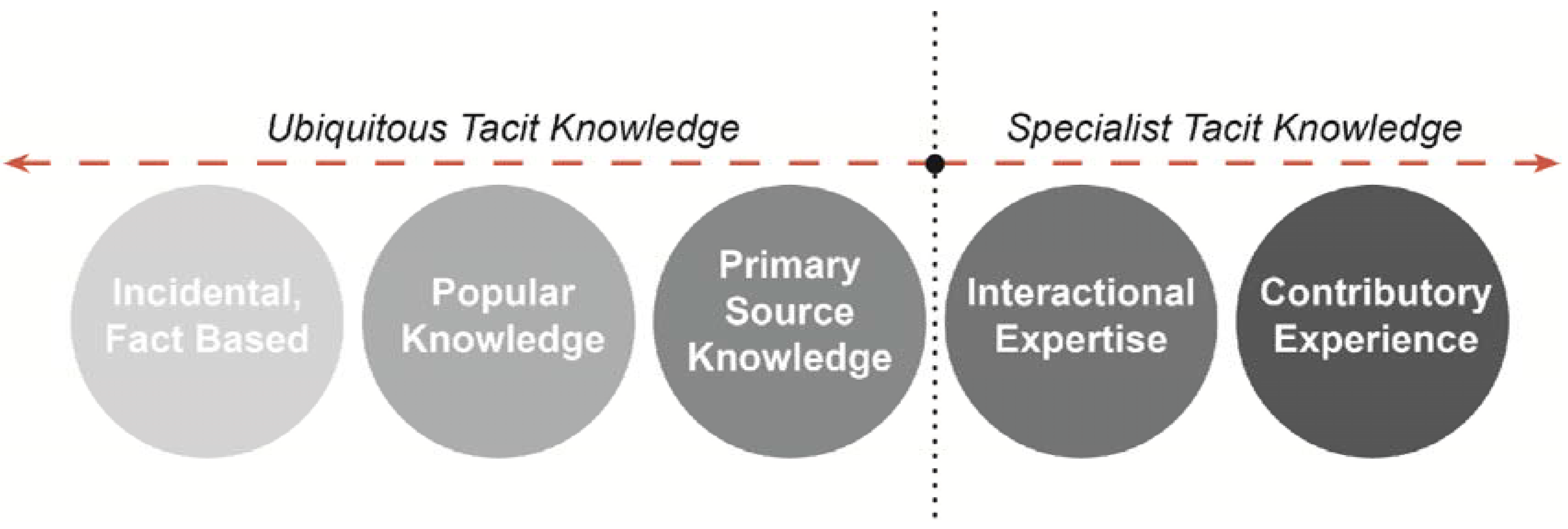
3.3. Sustainable Construction
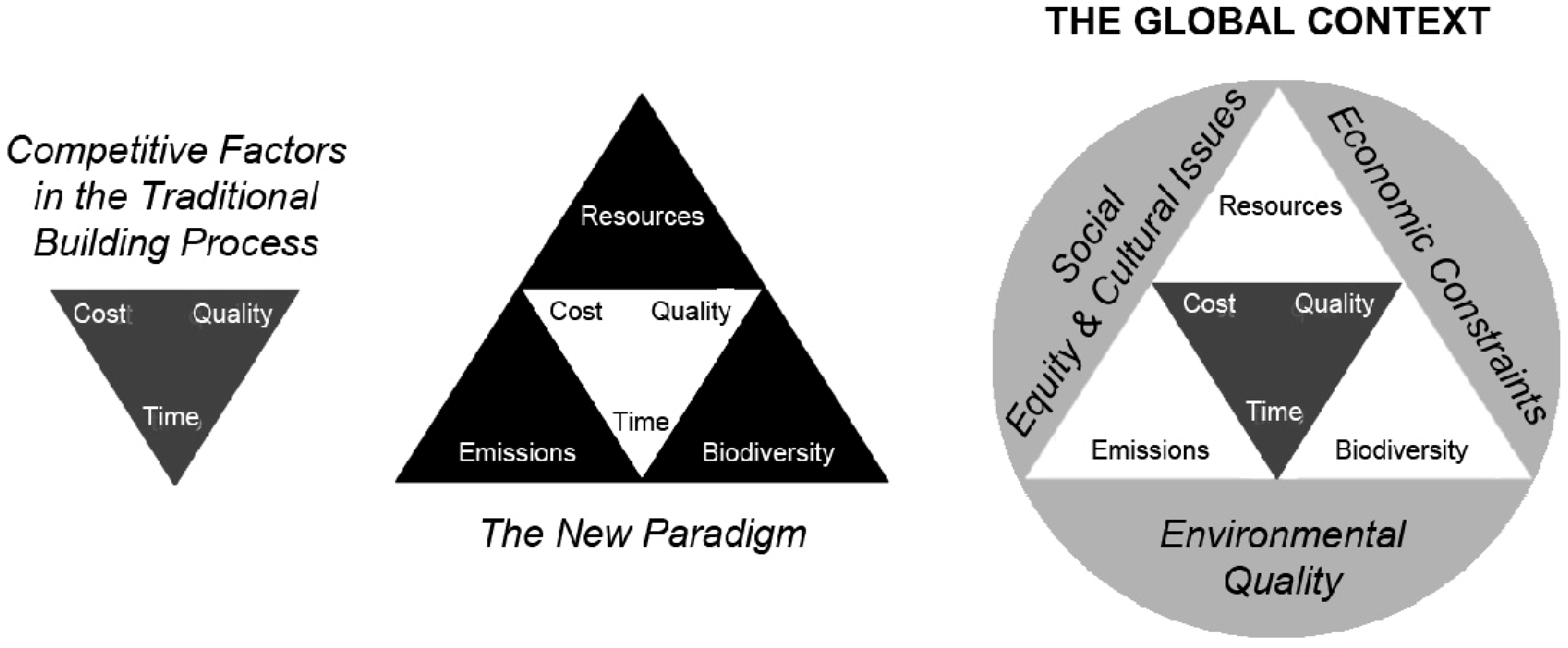
3.4. Drivers & Barriers
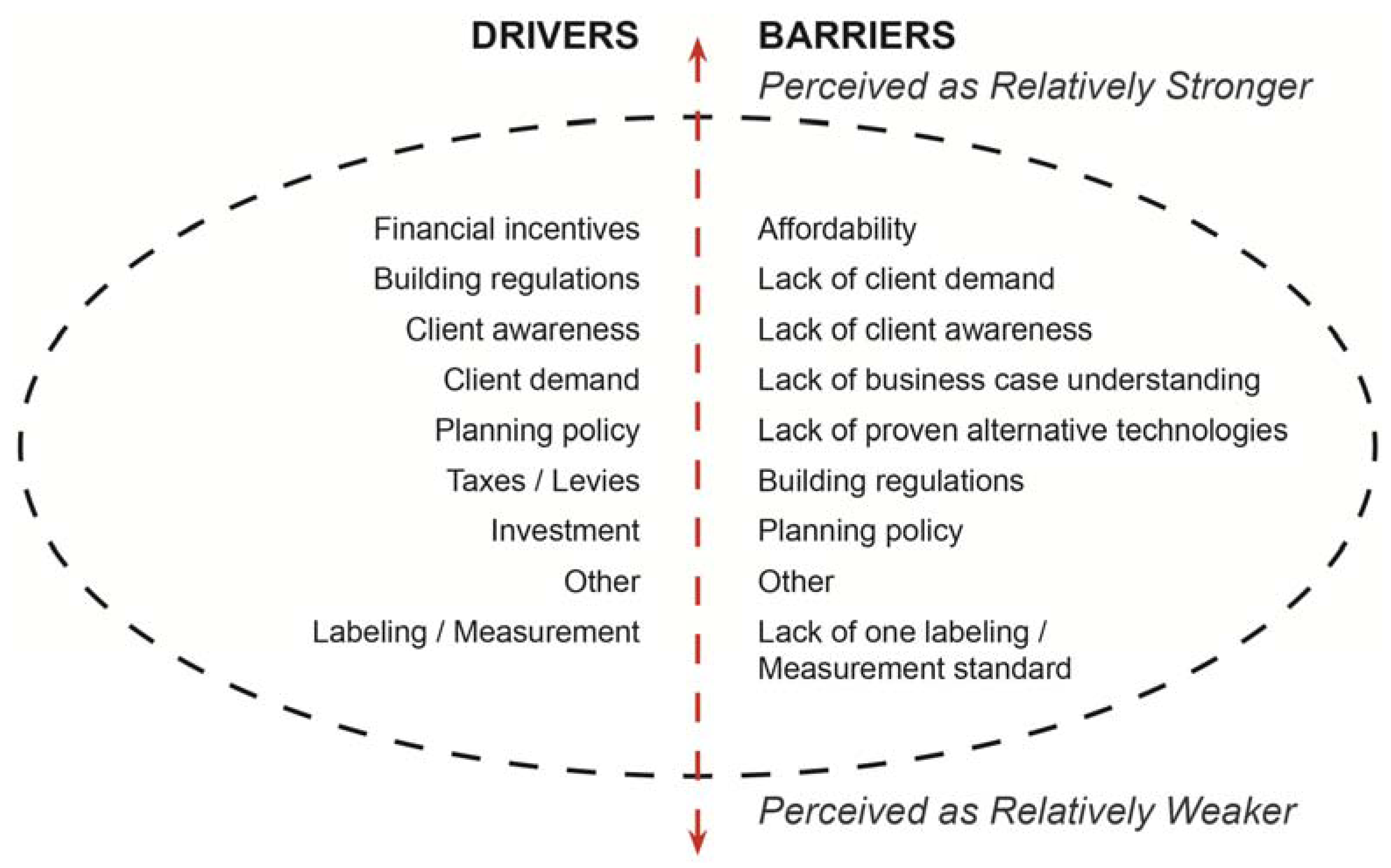
4. Case Country Switzerland
4.1. Federal Legislation

4.2. Construction Standards & Voluntary Labels
4.3. Knowledge Transfer Organizations
5. Empirical Work
5.1. Method

5.2. Summary Results
5.2.1. Interviews
| Group | Descriptions |
|---|---|
| A. | By Education |
| 1. Architecture & Planning (n = 20) * | |
| - Architect, Planner, Educator | |
| - Architect, Planner, City Project Manager | |
| - Architect, City Project Manager | |
| - Architect, Research Scientist, Prototype Research & Design | |
| - Architect, Research Scientist, Software Developer, Educator, Prototype Research & Design | |
| - Architect, Firm Owner, Executive Director of Sustainability Knowledge Transfer Organization | |
| - Architect, Firm Owner, Federal Advisory Panel Participant | |
| - Architect, Firm Owner, Prototype Research & Design | |
| - Architect, Firm Owner, Cooperative Housing Construction Management | |
| - Architect, Firm Owner | |
| - Architect, Firm Owner | |
| - Architect, Firm Owner | |
| - Architect, Firm Owner | |
| - Architect, Firm Owner, Educator | |
| - Architect, Firm Owner, Educator | |
| - Architect, Senior Project Architect | |
| - Architect, Competition Design, Graphics | |
| - Architect, Energy Modeling | |
| 2. Engineering Specialty (n = 10) * | |
| - Engineer, Research Scientist, Educator | |
| - Engineer, Senior Research Scientist, Educator, Prototype Research & Design | |
| - Engineer, Senior Research Scientist, Educator | |
| - Engineer, Senior Research Scientist, Consultant | |
| - Engineer, Senior Project Manager | |
| - Engineer, Project Manager | |
| - Engineer, Communications Officer of Sustainability Knowledge Transfer Organization | |
| - Executive Director of Sustainability Knowledge Transfer Organization, Educator | |
| * Architect, Specialist in Building Physics, Technical Director of Certification Label, Educator | |
| * Architect, Engineer, Sustainability Consultant, Firm Owner | |
| 3. Other (n = 3) | |
| - Senior Research Scientist, Consultant to City Mobility Planning, Energy Transitions | |
| - Director of Energy/Mobility Research Institute, Upcoming Executive Director of Sustainability Knowledge Transfer Organization | |
| - City Project Manager, Energy Award Program |
| Group | Interviewees | Men | Women | Total (n) | Percent |
|---|---|---|---|---|---|
| A. | By Education | ||||
| 1. Architecture & Planning * | 16 | 4 | 20 * | 60.6% | |
| 2. Engineering Specialty * | 8 | 2 | 10 * | 30.3% | |
| 3. Other | 2 | 1 | 3 | 9.1% | |
| 24 | 7 | 33 * | 100.0% | ||
| B. | By Highest Qualification | ||||
| 1. Professional Degree | 18 | 4 | 22 | 71.0% | |
| 2. PhD | 4 | 3 | 7 | 22.6% | |
| 3. Other | 2 | – | 2 | 6.4% | |
| 24 | 7 | 31 | 100.0% | ||
| C. | By Practice | ||||
| a. | Primary | ||||
| 1. Design | 15 | 3 | 18 | 58.1% | |
| 2. Research | 4 | 2 | 6 | 19.3% | |
| 3. Management/Coordination of Research | 4 | – | 4 | 12.9% | |
| 4. Management/Coordination of Design | 1 | 2 | 3 | 9.7% | |
| 24 | 7 | 31 | 100.0% | ||
| b. | Secondary | ||||
| 1. Management/Coordination of Design | 8 | 1 | 9 | 29.0% | |
| 2. Education | 8 | – | 8 | 25.8% | |
| 3. Consultancy/Advisory | 3 | 4 | 7 | 22.6% | |
| 4. Other | 4 | – | 4 | 12.9% | |
| 5. Research | 1 | 2 | 3 | 9.7% | |
| 24 | 7 | 31 | 100.0% | ||
| c. | Tertiary | ||||
| 1. Other | 13 | 3 | 16 | 51.6% | |
| 2. Consultancy/Advisory | 5 | 1 | 6 | 19.4% | |
| 3. Education | 2 | 3 | 5 | 16.1% | |
| 4. Management/Coordination of Design | 4 | – | 4 | 12.9% | |
| 24 | 7 | 31 | 100.0% | ||
| D. | By Position (Stakeholder Type) | ||||
| 1. Planners & Designers | 15 | 2 | 17 | 54.8% | |
| 2. Research & Education | 8 | 3 | 11 | 35.5% | |
| 3. Public Authorities | 1 | 2 | 3 | 9.7% | |
| 24 | 7 | 31 | 100.0% |
- The sample reflects the views of experts trained primarily within the design disciplines of architecture and planning, as well as the engineering design disciplines, 60.6% and 30.3% respectively, with an additional 9.1% representing other types of training, specifically economics and geography. It is important to note that as indicated by asterisk (*), two the interviewees were qualified as both engineers and architects, therefore the total surpasses 31.
- Grouped by highest qualification, 71% of the interview sample held a professional degree with 22.6% holding a doctoral qualification and 6.4% holding other types of qualifications, specifically a MBA and a Bachelor’s Degree respectively.
- (a) Parsed by practice, the primary activity of the interviewees mainly involved design work at 58.1 percent, followed by research activities at 19.3%, the management and/or coordination of research at 12.9%, and lastly the management and/or coordination of design at 9.7%.(b) Assessed by secondary practice, the majority of interviewees engaged in the management and/or coordination of research at 29%, followed by education related activities at 25.8%, consultancy/advisory at 22.6%, other activities at 12.9%, and finally research related activities at 9.7%.(c) Evaluated by tertiary practice, interviewees’ responses were much more diverse with 51.6% reporting a range of activities unrelated to sustainable construction, followed by 19.4% indicating consultancy and/or advisory activities, 16.1% engaged in activities related to education, and 12.9% involved in managing or coordinating design.
- Aggregated by stakeholder type, primarily planners and designers were represented at 54.8%, followed by the interests of research and education at 35.5%, and lastly by the public authorities at 9.7%.
5.2.2. Collated Responses of Interviews by Practice (Category C)
5.2.3. Challenges Linked to Technical Aspects of Sustainable Construction
| Group | Interviewees | Men | Women | Subtotal | Total (n) | Percent |
|---|---|---|---|---|---|---|
| C. | By Practice | |||||
| d. | Primary Practice Responses Collated | |||||
| 1. Design | 15 | 3 | 18 | 21 | 67.7% | |
| + Management/Coordination of Design | 1 | 2 | 3 | |||
| 2. Research | 4 | 2 | 6 | 10 | 32.3% | |
| + Management/Coordination of Research | 4 | – | 4 | |||
| 24 | 7 | 31 | 31 | 100.0% | ||
| e. | All Practice Responses * Collated | |||||
| 1. Design | 15 | 3 | 18 | 34 | 46.6% | |
| + Management/Coordination of Design | 13 | 3 | 16 | |||
| 2. Research | 5 | 4 | 9 | 13 | 17.8% | |
| + Management/Coordination of Research | 4 | – | 4 | |||
| 3. Education | 10 | 3 | 13 | 13 | 17.8% | |
| 4. Consultancy/Advisory | 8 | 5 | 13 | 13 | 17.8% | |
| 55 | 18 | 73 | 73 | 100.0% |
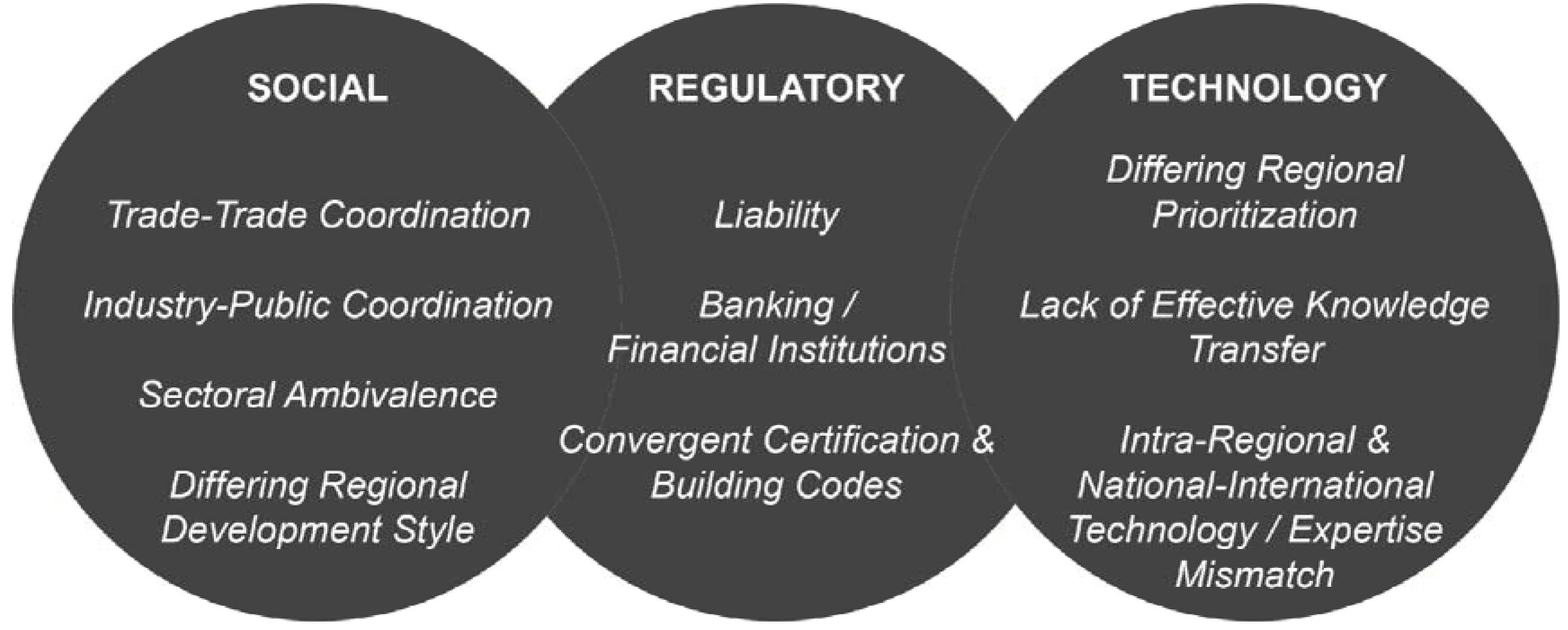
6. Discussion
6.1. Context Counts
6.1.1. Domestic
6.1.2. International
6.2. Mediating Frictions between Regulation & Innovation
6.2.1. The Convergence of Standards
6.2.2. Liability
7. Conclusions
For a greater degree of fact stabilization than using boundary objects. Simultaneously, however, standardized packages are also similar to boundary objects in that they facilitate interactions and cooperative work between social worlds and increase their opportunities for being transferred into, and enrolling members of, other worlds. They serve as interfaces between multiple social worlds which facilitates the flow of resources (concepts, skills, materials, techniques, instruments) among multiple lines of work [10].
They [experts] do not have contextually disembodied technologies transferred upon them. Instead they acquire and develop knowledges which mesh with and which emerge out of local, culturally and temporally specific working environments [10].
Acknowledgments
Conflicts of Interest
References and Notes
- Intergovernmental Panel on Climate Change. First Assessment Report Overview Chapter. Available online: http://www.ipcc.ch/ipccreports/1992%20IPCC%20Supplement/IPCC_1990_and_1992_Assessments/English/ipcc_90_92_assessments_far_overview.pdf (accessed on 19 June 2013).
- Intergovernmental Panel on Climate Change. Climate Change 2001: Synthesis Report. Available online: http://www.ipcc.ch/pdf/climate-changes-2001/synthesis-syr/english/front.pdf (accessed on 19 June 2013).
- Intergovernmental Panel on Climate Change. Climate Change 2007: Synthesis Report. Available online: http://www.ipcc.ch/pdf/assessment-report/ar4/syr/ar4_syr_frontmatter.pdf (accessed on 19 June 2013).
- Marszal, A.J.; Bourrelle, J.S.; Musall, E.; Heiselberg, P.; Gustavsen, A.; Voss, K. Net Zero Energy Buildings—Calculation Methodologies versus National Building Codes. In Proceedings of EuroSun 2010: International Conference on Solar Heating, Cooling and Buildings, Graz, Austria, 28 September—1 October 2010.
- Murphy, L.; Meijer, F.; Visscher, H. Governance Tools. In Sustainable Urban Environments: An Ecosystem Approach; Springer: New York, NY, USA, 2012; pp. 341–363. [Google Scholar]
- Schweber, L.; Leiringer, R. Beyond the technical: A snapshot of energy and buildings research. Build. Res. Inf. 2012, 40, 481–492. [Google Scholar] [CrossRef] [Green Version]
- Sørensen, K.H. Providing, Pushing and Policing. Towards a New Architecture of Technology Policy. In Technology Studies and Sustainable Development; Profil Publishers: Vienna, Austria, 2002; pp. 65–94. [Google Scholar]
- Gray, P.C.R.; Wiedemann, P.M. Risk management and sustainable development: Mutual lessons from approaches to the use of indicators. J. Risk Res. 1999, 2, 201–218. [Google Scholar] [CrossRef]
- Ryghaug, M. Towards a Sustainable Aesthetics, Architects Constructing Energy Efficient Buildings. Ph.D. Thesis, Norwegian University of Science and Technology, Trondheim, Norway, September 2002; p. 66. [Google Scholar]
- Shove, E. Gaps, barriers and conceptual chasms: Theories of technology transfer and energy in buildings. Energy Policy 1998, 26, 1105–1112. [Google Scholar] [CrossRef]
- Amsterdamska, O. Practices, People, and Places. In The Handbook of Science and Technology Studies; MIT Press: Cambridge, MA, USA, 2008; pp. 205–210. [Google Scholar]
- Evans, R.; Collins, H. Expertise: From Attribute to Attribution and Back Again? In The Handbook of Science and Technology Studies; MIT Press: Cambridge, MA, USA, 2008; pp. 609–630. [Google Scholar]
- Freitag, M.; Vatter, A. Political institutions and the wealth of regions: Swiss cantons in a comparative perspective. Eur. Urban Reg. Stud. 2004, 11, 291–301. [Google Scholar] [CrossRef]
- Latour, B. Science in Action: How to Follow Scientists and Engineers Through Society; Harvard UP: Cambridge, MA, USA, 1987. [Google Scholar]
- Pickering, A. Science as Practice and Culture; University of Chicago Press: Chicago, IL, USA, 1992. [Google Scholar]
- Knorr-Cetina, K. Epistemic Cultures: How the Sciences Make Knowledge; Harvard UP: Cambridge, MA, USA, 1999. [Google Scholar]
- Latour, B.; Woolgar, S. Laboratory Life: the Social Construction of Scientific Facts; Princeton UP: Princeton, NJ, USA, 1986. [Google Scholar]
- Gieryn, T. Cultural Boundaries of Science: Credibility on the Line; University of Chicago Press: Chicago, IL, USA, 1999. [Google Scholar]
- Gieryn, T. Boundary-work and the demarcation of science from non-science: Strains and interests in professional ideologies of scientists. Am. Sociol. Rev. 1983, 48, 781–795. [Google Scholar] [CrossRef]
- Clark, W.C.; Tomich, T.P.; van Noordwijk, M.; Dickson, N.M.; Catacutan, D.; Guston, D.; McNie, E. Toward a General Theory of Boundary Work: Insights from the CGIAR’s Natural Resource Management Programs. In Faculty Research Working Paper Series, Sustainability Science Program; Harvard Kennedy School of Government Harvard University: Cambridge, MA, USA, 2010. [Google Scholar]
- Hoppe, R. From “Knowledge Use” towards “Boundary Work”. Sketch of an Emerging New Agenda for Inquiry into Science-Policy Interaction. In Knowledge Democracy. Consequences for Science, Politics and Media; Springer: Heidelberg, Germany, 2010; pp. 169–186. [Google Scholar]
- Clarke, A. Social Worlds/Arenas Theory as Organizational Theory. In Social Organization and Social Process: Essays in Honor of Anselm Strauss; Aldine de Gruyter: New York, NY, USA, 1991; pp. 119–158. [Google Scholar]
- Star, S.L. Power, Technology and the Phenomenology of Conventions: On Being Allergic to Onions. In A Sociology of Monsters: Essays on Power, Technology and Domination; Routledge: London, UK, 1991; pp. 26–56. [Google Scholar]
- Star, S.L.; Griesemer, J.R. Institutional ecology, translations, and coherence: Amateurs and professionals in Berkley’s Museum of vertebrate zoology, 1907–1938. Soc. Stud. Sci. 1989, 19, 387–420. [Google Scholar] [CrossRef]
- Hackett, E.J.; Amsterdamska, O.; Lynch, M.; Wajcman, J. The Handbook of Science and Technology Studies; MIT Press: Cambridge, MA, USA, 2008. [Google Scholar]
- Fujimura, J. Bandwagons in Science: Doable Problems and Transportable Packages as Factors in the Development of the Molecular Genetic Bandwagon in Cancer Research. Ph.D. Thesis, University of California, Berkeley, CA, USA, November 1986. [Google Scholar]
- Fujimura, J. The Molecular biological bandwagon in cancer research: Where social worlds meet. Soc. Probl. 1988, 35, 261–283. [Google Scholar] [CrossRef]
- Fujimura, J. Crafting Science: Standardized Packages, Boundary Objects, and Translation. In Science as Practice and Culture; University of Chicago Press: Chicago, IL, USA, 1992; pp. 168–214. [Google Scholar]
- Latour, B.; Yaneva, A. Give Me a Gun and I Will Make All Buildings Move: An ANT’s View of Architecture. In Explorations in Architecture: Teaching, Design, Research; Birkhäuser: Basel, Switzerland, 2008; pp. 80–89. [Google Scholar]
- Star, S.L. The Structure of Ill-Structured Solutions: Boundary Objects and Heterogeneous Distributed Problem Solving. In Readings in Distributed Artificial Intelligence; Morgan Kaufman: San Francisco, CA, USA, 1988; pp. 37–54. [Google Scholar]
- Guston, D.H. Boundary organizations in environmental policy and science: An introduction. Sci. Technol. Hum. Values 2001, 26, 399–408. [Google Scholar] [CrossRef]
- Gerring, J. What is a case study and what is it good for? Am. Polit. Sci. Rev. 2004, 98, 341–454. [Google Scholar] [CrossRef]
- Teddlie, C.; Yu, F. Mixed methods sampling: A typology with examples. J. Mix. Methods Res. 2007, 1, 77–100. [Google Scholar] [CrossRef]
- Flyberg, B. Case Study. In The Sage Handbook of Qualitative Research; Sage: Newbury Park, CA, USA, 2011; pp. 201–316. [Google Scholar]
- Hemmati, M. Multi-Stakeholder Processes for Governance and Sustainability: Beyond Deadlock and Conflict; Earthscan: London, UK, 2002. [Google Scholar]
- Yang, J.; Shen, Q.; Ho, M. An overview of previous studies in stakeholder management and its implications for the construction industry. J. Facil. Manag. 2009, 7, 159–175. [Google Scholar] [CrossRef]
- Bal, M.; Bryde, B.; Fearon, D.; Ochieng, E. Stakeholder engagement: Achieving sustainability in the construction sector. Sustainability 2013, 6, 695–710. [Google Scholar]
- Feige, A.; Wallbaum, H.; Krank, S. Harnessing stakeholder motivation: Towards a Swiss sustainable building sector. Build. Res. Inf. 2011, 39, 504–517. [Google Scholar] [CrossRef]
- Roloff, J. Learning from multi-stakeholder networks: Issue-focused stakeholder management. J. Bus. Ethics 2008, 82, 233–250. [Google Scholar] [CrossRef]
- Friedman, A.L.; Miles, S. Stakeholders: Theory and Practice; Oxford University Press: Oxford, UK, 2006. [Google Scholar]
- Jasanoff, S. (No?) Accounting for expertise. Sci. Public Policy 2003, 6, 221–232. [Google Scholar]
- Jasanoff, S. Breaking the waves in science studies: Comment on H.M. Collins and Rober Evans, the third wave of science studies. Soc. Stud. Sci. 2003, 33, 389–400. [Google Scholar] [CrossRef]
- Halliday, S. Sustainable Construction; Butterworth Heinemann: London, UK, 2008. [Google Scholar]
- Bourdeau, L. Sustainable development and the future of construction: A comparison of visions from various countries. Build. Res. Inf. 1999, 27, 354–366. [Google Scholar]
- Hill, R.H.; Bowen, P.A. Sustainable construction: Principles and a framework for attainment. Constr. Manag. Econ. 1997, 15, 223–239. [Google Scholar]
- Akadiri, P.O.; Chinyio, E.A.; Olomolaiye, P.O. Design of a sustainable building: A conceptual framework for implementing sustainability in the building sector. Buildings 2012, 2, 126–152. [Google Scholar] [CrossRef]
- Zimmermann, M.; Althaus, H.J.; Haas, A. Benchmarks for sustainable construction: A contribution to develop a standard. Energy Build. 2005, 37, 1147–1157. [Google Scholar] [CrossRef]
- Van Bueren, E.M.; Priemus, H. Institutional barriers to sustainable construction. Environ. Plan. Plan. Des. 2002, 29, 75–86. [Google Scholar]
- Zimmerman, M. Energy situation and policy in Switzerland. Int. J. Ambient Energy 2001, 22, 29–34. [Google Scholar] [CrossRef]
- Pitt, M.; Tucker, M.; Riley, M.; Longden, J. Towards sustainable construction: Promotion and best practices. Constr. Innov. Inf. Process Manag. 2009, 9, 201–224. [Google Scholar]
- Ziegler, M. Swiss Greenhouse Gas Abatement Cost Curve; McKinsey & Company: Zurich, Switzerland, 2009; p. 6. [Google Scholar]
- Swiss Federal Office of Energy SFOE. Energy Consumption in Switzerland 2012. Available online: http://www.news.admin.ch/NSBSubscriber/message/attachments/31150.pdf (accessed on 19 June 2013).
- Swiss Federal Office of Energy SFOE. Energy Consumption up 3.7% in 2012. Available online: http://www.bfe.admin.ch/energie/00588/00589/00644/index.html?lang=en&msg-id=49443 (accessed on 19 June 2013).
- European Commission Eurostat. Glossary: Carbon Dioxide Equivalent. Available online: http://epp.eurostat.ec.europa.eu/statistics_explained/index.php/Glossary:CO2_equivalent (accessed on 28 June 2013). Excerpt from site: “A carbon dioxide equivalent or CO2 equivalent, abbreviated as CO2-eq [or CO2e] is a metric measure used to compare the emissions from various greenhouse gases on the basis of their global-warming potential (GWP), by converting amounts of other gases to the equivalent amount of carbon dioxide with the same global warming potential”.
- The Federal Authorities of the Swiss Confederation Homepage. Federal Constitution of the Swiss Confederation from 18 April 1999. Available online: http://www.admin.ch/org/polit/00083/?lang=en (accessed on 19 June 2013).
- Die Bundesversammlung der Schweizerischen Eidgenossenschaft. Energy Act or Energiegesetz—EnG (SR 730). Available online: http://www.admin.ch/opc/de/classified-compilation/19983485/index.html (accessed on 19 June 2013).
- Die Bundesversammlung der Schweizerischen Eidgenossenschaft. 2000 Carbon Dioxide Act or CO2 Gesetz. (SR 641.71). Available online: http://www.admin.ch/opc/de/classified-compilation/20091310/index.html (accessed on 19 June 2013).
- Nicol, L.A.; Hugentobler, M.; van Wezemael, J. Switzerland: Non-Profit Housing Sector—A Leader in Energy Efficiency Intiatives. In Energy Efficiency in Housing Management: Policies and Practice in Eleven Countries; Routledge: New York, NY, USA, 2012; pp. 133–150. [Google Scholar]
- Das Gebäudeprogramm Homepage. Steht eine Erneuerung Ihrer Liegenschaft an? Available online: http://www.dasgebaeudeprogramm.ch (accessed on 19 June 2013).
- Swiss Association of Architects and Engineers (SIA) Homepage. Available online: http://www.sia.ch (accessed on 14 January 2011).
- Konferenz. Kontonaler. Energiedirecktore Homepage. Available online: http://www.endk.ch (accessed on 19 January 2011).
- Minergie Homepage. Available online: http://www.minergie.ch (accessed on 14 January 2011).
- Fachbeitraege: Branche. Bauen wir bald nach Minergie Zero? Available online: http://www.baublatt.ch/fachbeitraege/bau_branche/bauen-wir-bald-nach-minergie-zero# (accessed on 3 July 2012).
- Swiss Network for Sustainable Construction Homepage. Available online: http://www.nnbs.ch (accessed on 1 June 2013).
- SIA 112/1 Recommendation for Sustainable Building Construction. Published in 2004, the SIA Outlined Comprehensive Guidelines for Defining Sustainable Construction.
- Swiss Energy Homepage. Available online: http://www.energieschweiz.ch (accessed on 19 June 2013).
- Novatlantis, Sustainability at the ETH Domain Homepage. Available online: http://www.novatlantis.ch (accessed on 12 November 2010).
- Swiss Federal Council. Sustainable Development Strategy, Guidelines and Action Plan 2008–2011, 16 April 2008. Available online: http://www.sib.admin.ch/uploads/media/Strategie_NE_08_en_02.pdf (accessed on 4 June 2013).
- Swiss Federal Council. Sustainable Development Strategy 2012–2015, 25 January 2012. Available online: http://www.are.admin.ch/themen/nachhaltig/00262/00528/index.html?lang=en (accessed on 4 June 2013).
- SIA Homepage. Fachzeitschriften. Available online: http://www.sia.ch/de/dienstleistungen/fachzeitschriften/ (accessed on 21 June 2013).
- Guy, S.; Shove, E. A Sociology of Energy, Buildings and the Environment: Constructing Knowledge, Designing Practice; Routledge: London, UK, 2000; p. 21. [Google Scholar]
- Erk, J. Swiss federalism and congruence. Natl. Ethn. Polit. 2003, 9, 50–74. [Google Scholar] [CrossRef]
- The City of Zürich Homepage. 2000-Watt Society. Available online: http://www.stadt-zuerich.ch/2000-watt-society (accessed on 19 June 2013).
- Novatlantis Homepage. The 2000-Watt Society. Available online: http://www.novatlantis.ch/en/2000watt.html (accessed on 19 June 2013).
- 2000-Watt-Gesellschaft Homepage. Available online: http://www.2000watt.ch (accessed on 19 June 2013).
- Genève à 2000 watts Homepage. Available online: http://www.geneve2000watts.ch/home.php (accessed on 19 June 2013).
- Stulz, R. The 2000 Watt Society: Experiences in Zurich and Basel. Available online: http://www.energy-cities.eu/IMG/pdf/stulz_imagine.pdf (accessed on 13 July 2013).
- Anecdotally, one interviewee, who was a qualified mechanical engineer, researcher and educator, even went so far as to self-finance a building project, hire a design team and implement his prototype system of integrated building technologies. However, according to both the project architect, and the energy modeler the introduction of atypical construction details was still a strong source of friction between the design team and the construction trades in terms of perceived liability, schedule and cost.
- Borup, M.; Brown, N.; Konrad, K.; van Lente, H. The sociology of expectations in science and technology. Technol. Anal. Strateg. Manag. 2006, 18, 285–298. [Google Scholar] [CrossRef]
© 2013 by the authors; licensee MDPI, Basel, Switzerland. This article is an open access article distributed under the terms and conditions of the Creative Commons Attribution license (http://creativecommons.org/licenses/by/3.0/).
Share and Cite
Bharathi, K.; Nicol, L.A. Between Research and Practice: Experts on Implementing Sustainable Construction. Buildings 2013, 3, 739-765. https://doi.org/10.3390/buildings3040739
Bharathi K, Nicol LA. Between Research and Practice: Experts on Implementing Sustainable Construction. Buildings. 2013; 3(4):739-765. https://doi.org/10.3390/buildings3040739
Chicago/Turabian StyleBharathi, Krishna, and Lee Ann Nicol. 2013. "Between Research and Practice: Experts on Implementing Sustainable Construction" Buildings 3, no. 4: 739-765. https://doi.org/10.3390/buildings3040739




